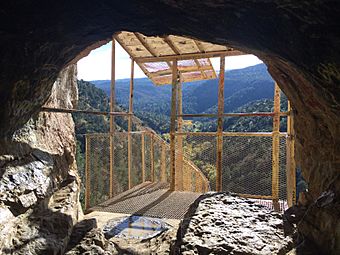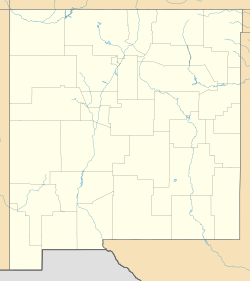Sandia Cave facts for kids
|
Sandia Cave
|
|

View from inside the cave.
|
|
| Nearest city | Bernalillo, New Mexico |
|---|---|
| Area | 130 acres (53 ha) |
| NRHP reference No. | 66000487 |
Quick facts for kids Significant dates |
|
| Added to NRHP | October 15, 1966 |
| Designated NHL | January 20, 1961 |
Sandia Cave, also known as the Sandia Man Cave, is an important archaeological site in New Mexico. It is located near Bernalillo, New Mexico, inside the Cibola National Forest.
Scientists first found and explored this cave in the 1930s. They discovered signs that people lived or used the cave between 9,000 and 11,000 years ago. Because of its historical importance, Sandia Cave was named a National Historic Landmark in 1961. Today, you can visit the cave, but it's a bit of a challenging hike up a trail from New Mexico State Road 165.
Exploring Sandia Cave
Sandia Cave is found on a very steep side of the Las Huertas Canyon. This canyon is on the north side of the Sandia Mountains, northeast of Albuquerque, New Mexico.
To get to the cave, you start at a public path on the east side of New Mexico State Road 165. The journey to the cave can be tricky. It involves walking along narrow ledges and climbing a steep metal staircase.
The Story of Sandia Cave
The cave was first discovered in 1936. For many years, archaeologists debated what the findings in the cave meant. This made it hard to fully understand how important the site was.
Between the 1930s and 1940s, a scientist named Frank Hibben from the University of New Mexico led excavations here. During these digs, researchers found two types of ancient hunting tools: Folsom points and Sandia points.
Hibben believed the Sandia points were much older than any other human tools found in North America at that time. They also found bones of animals that are now extinct, meaning they lived during the Ice Age. Later studies used new methods to figure out the true age of the items. These studies showed that the "Sandia Man" tools were not as old as first thought.
Ancient Animals of Sandia Cave
The bones found by Hibben and other researchers tell us a lot about the animals that lived here long ago. They found remains of huge, extinct animals like mammoths, mastodons, giant sloths, ancient horses, and camels.
They also found bones from many types of mammals and birds that survived the end of the Ice Age. This makes Sandia Cave one of the most important places in northern New Mexico for learning about animals from the Ice Age.
See also




